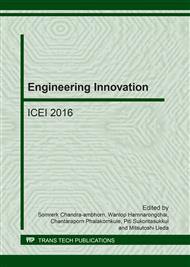p.235
p.240
p.246
p.252
p.258
p.264
p.271
p.277
p.283
Interfacial Characteristics of Insert-Injection Molding by Using Acoustic Emission
Abstract:
Aim of this study focused on insert injection molding process, which is molded the melted polymer around an inserted part placed in the molded cavity of injection molding process. The interfacial adhesive strength between the inserted and an injected polymer parts were investigated by Intron universal test machine in order to investigate the effect of material in inserted and injected part. During tensile testing the acoustic emissions (AE) measurement was applied to evaluate the fracture behavior of insert injection molding. It was found that interfacial adhesive strength of insert injection molded of all specimens increased according with increasing the bonding area of adhesive interface. The fracture mode of the insert injection molded specimens was depended on the length of bonding area of the inserted part. The fracture of mode of the insert-injection molded specimens was confirmed by acoustic emission.
Info:
Periodical:
Pages:
258-263
Citation:
Online since:
January 2017
Price:
Сopyright:
© 2017 Trans Tech Publications Ltd. All Rights Reserved
Share:
Citation:


